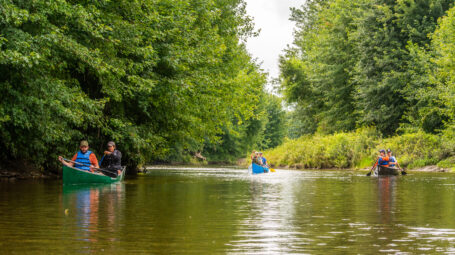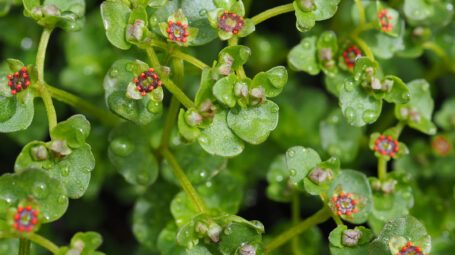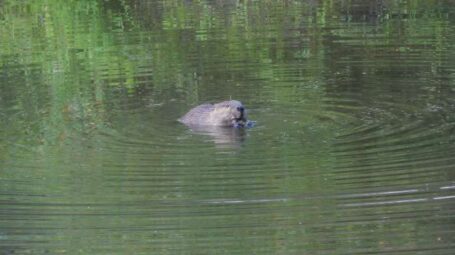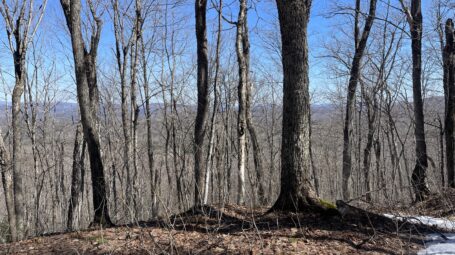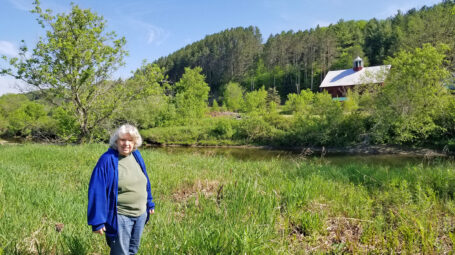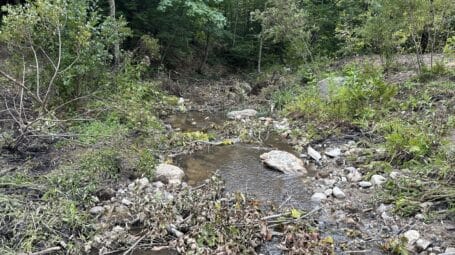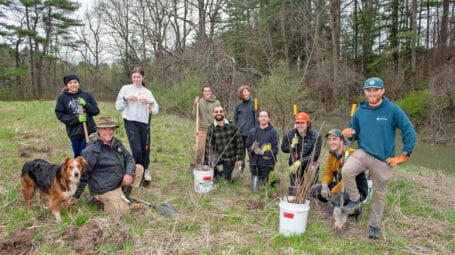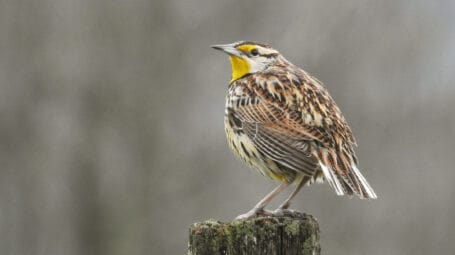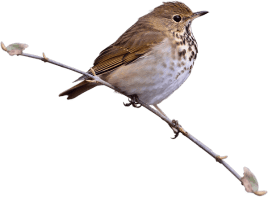Conservation organizations planted 5,500 trees and shrubs earlier this year in watersheds hit hard by the July storms, the Vermont Land Trust and Franklin County Natural Resources Conservation District announced.
The plantings will help restore streams and reduce flood damage, and also improve wildlife habitat. They took place along wetlands, Lewis Creek and tributaries of the New Haven River as well as the Lamoille River. These restoration projects were completed on farms in Middlebury, Hinesburg, Charlotte and Fletcher.
“This month, Vermonters once again witnessed the awesome and terrifying power of water,” said Allaire Diamond, an ecologist with the Vermont Land Trust. “Re-foresting land along streams is one of the best ways to slow flood waters and reduce downstream damage. The trees that we planted this year and in previous years held up well during our recent storms, though we are still assessing full impacts as we monitor each site.”
Partners included Audubon Vermont, Partners for Fish and Wildlife, Lewis Creek Association and VLT, with over 50 volunteers from Waterbury-based Ursa Major Skincare, the citizen science group River Watch, UVM students and the wider community.
“Rivers and streams need healthy floodplains – the wide, meandering areas around them that fill with water when there are weather events like the ones we experienced this month,” continued Diamond. “Re-foresting those spaces not only slows and holds water, it also traps flood-borne material and absorbs nutrients, resulting in cleaner water downstream.”
Farms in Middlebury, Hinesburg and Charlotte welcomed trees
A thousand trees were planted in Middlebury along Muddy Branch, a tributary of the New Haven River, at the VLT-conserved LedgEnd Farm. The multi-day effort brought together farmer Hank Dimuzio, volunteers from the citizen science group River Watch, ECO AmeriCorps members, Middlebury College students and VLT supporters and staff.
Dimuzio raises European fallow deer for venison and agreed to set aside two and a half acres along Muddy Branch for clean water. “I was willing to sacrifice the roughly three weeks’ worth of feed from that land,” to promote clean water, he said. Dimuzio also looks forward to the planted trees eventually shading the area and preventing invasive plants from establishing. “I think this planting is a very good solution,” said Dimuzio.
Further north in Hinesburg, VLT staff led volunteers in planting 800 trees along Lewis Creek on a VLT-conserved farm owned by John and Pamela Robichaud. Volunteers from Trout Unlimited, UVM and Waterbury-based Ursa Major Skincare came out to join VLT supporters and staff in the effort.
These restoration projects in Middlebury and Hinesburg were funded by the Otter Creek Basin Clean Water Service Provider and the U.S. Fish and Wildlife Service. Plants included shrub willow, silky dogwood, nannyberry, tamarack, highbush cranberry, white pine and elderberry, among other species.
In a separate effort, Audubon Vermont led a planting of 200 trees in a streamside wetland area on the VLT-conserved Philo Ridge Farm in Charlotte. This was the second phase of a restoration effort here; in the first phase, 200 trees were planted in 2022.
Over 3,000 trees planted on Fletcher farm in Lamoille River watershed
The Franklin County Natural Resources Conservation District led a planting of 3,500 trees and shrubs along a tributary of the Lamoille River that flows through the VLT-conserved Boneyard Farm in Fletcher. Boneyard Farm produces meat, eggs, vegetables and value-added products.
A dozen volunteers from USDA Natural Resources Conservation District, U.S. Fish and Wildlife Service, UVM Extension, VLT staff and the local community joined the Franklin County Natural Resources Conservation District, and farmers Hannah and John Doyle for the effort.
Over four acres of streamside land were planted with nannyberry, chokecherry, red osier dogwood, elderberry, paper birch and willow. The plantings will slow and hold water, and result in cleaner water downstream.
The project was funded by the Natural Resources Conservation Council’s Trees for Streams Program, using funding from the Vermont Department of Environmental Conservation.
“Improving biodiversity on farms by planting trees meets many of our collective goals,” said Lauren Weston, District Manager with the Franklin County Natural Resources Conservation District. “It has a ripple effect on our streams, soils, plants, wildlife, and food systems. We can all be part of ecologically restorative solutions on the working landscape.”
There will be a public event cohosted by NOFA-VT at Boneyard Farm on Saturday, August 26 that will cover many of these topics to further these efforts on other lands.

